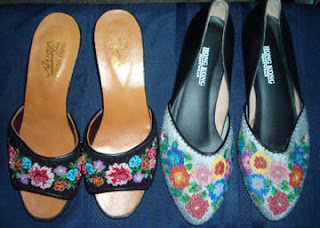My nonya (or nyonya) mother, who is a skilled beader, embroidered tiny seedbeads on to the tops of these beautiful shoes for me (lucky me!) She uses just one diagonal of the cross-stitch embroidery style to attach each bead to the aida cloth, taking great care to keep her tension even. She is a great inspiration to all as she is still beading well into her seventies.
Young nonya women from the late 19th century to WWII were taught to sew and embroider in preparation for their eventual marriages. A nonya bride was expected to present several pairs of embroidered or beaded slippers to the groom's family on her wedding day.
Check out this great video on the art of nonya beaded shoes:
References
Beautiful pictures of beaded slippers
Nonya slippers circa 1900
Who are the Peranakan?
Nonya Kebaya
______________________________
Original Post by THE BEADING GEM
Jewelry Making Tips - Jewelry Business Tips

I'm just travelling around the world and am currently in Malaysia where I saw some Nyonya beaded slippers in the Penang museum. I became a bit obsessed by them, hence how I cam upon your blog entry. The pair that your Mother embroidered are beautiful - you are very lucky!
ReplyDeleteThanks for dropping me a line! I know I am very, very lucky. Mum is making me a beaded bag now :-)
ReplyDeleteMy grandma is a Nyonya. It's a pity I didn't get to pick up any of her beading skills. I wish U have a chance to learn to cook Nyonya food and make beaded shoes...
ReplyDeleteHi there, actually i really interested to learn beading, and now searching for the place where got the beading classes. Do you have any idea? I'm from Klang.
ReplyDeleteDo you mean beading as in beaded cross stitch as shown in these shoes or beading as in jewelry making?
ReplyDeletePLS SEND ME MORE DETAIL ABOUT THE CLASSES.WHERE THE LOCATION ? DID U HAVE HIS PHONE NUMBER.....
ReplyDeleteboo_joeh_kian@hotmail.com
My mother who recently passed away left me her beaded shoes which she wore on her wedding.
ReplyDeletehttp://i127.photobucket.com/albums/p139/chrisgoh1/malaysia1031/PC110503.jpg
That's to be treasured! I too was given my grandmother's beaded shoes which she made for her own wedding.
ReplyDeleteHi dear I knw it's few yrs back ur post but I wanna ask if u are able to share the template of the shoe faces? Like what is the correct template.. I tried asking around but no one is able to help.. Could u please help??
ReplyDeleteMy elderly mother doesn't make the shoes anymore. Best thing is to go to a cobbler and get the right template from him to be sure the beaded pattern will fit.
ReplyDeleteAlso check out this blog post and the comments at the bottom - where you can contact someone in Malaysia who might be able to help - http://katonglife.blogspot.ca/2010/01/beginnings.html
Failing that, if you are making a soft pair of shoes for yourself entirely from scratch, adapt from an existing pattern. The shoe can be of any style.